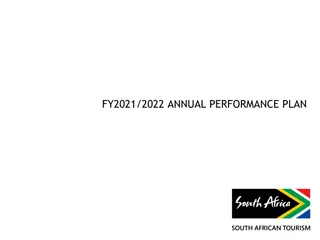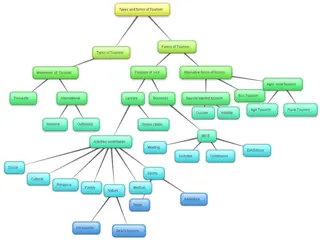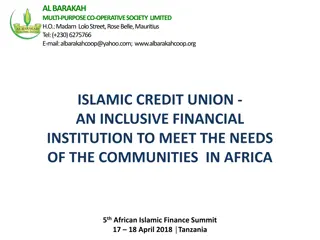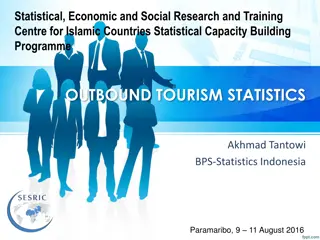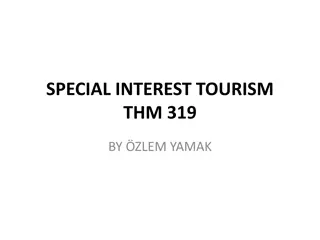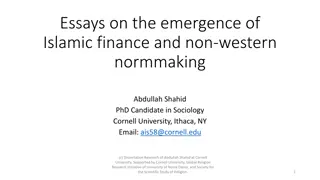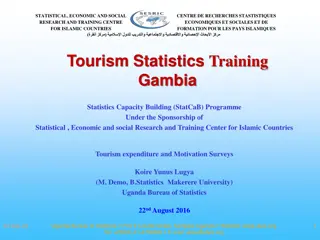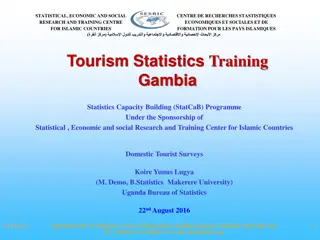Understanding Domestic Tourism Statistics in Islamic Countries
Awareness of the economic significance of domestic tourism is on the rise, with its contribution often surpassing that of inbound tourism. This article explores the measurement and importance of domestic tourism, focusing on aspects such as types of visitors, internal tourism, and recommended guidelines for defining domestic visitors.
Uploaded on Nov 13, 2024 | 0 Views
Download Presentation

Please find below an Image/Link to download the presentation.
The content on the website is provided AS IS for your information and personal use only. It may not be sold, licensed, or shared on other websites without obtaining consent from the author. Download presentation by click this link. If you encounter any issues during the download, it is possible that the publisher has removed the file from their server.
E N D
Presentation Transcript
Statistical, Economic and Social Research and Training Centre for Islamic Countries Statistical Capacity Building Programme DOMESTIC TOURISM STATISTICS Akhmad Tantowi BPS-Statistics Indonesia Paramaribo, 9 11 August 2016
Outline What is domestic tourism? Measuring flow and characteristics of domestic visitors Indonesia Domestic Tourism Statistics
Type of visitors International Domestic country of residence different from country visited Inbound visitors Outbound visitors country of residence the same as country visited
Internal tourism Domestic tourist Inbound tourist
Background The awareness of the economic importance of domestic tourism has grown significantly in recent years. Even though many countries have left the statistical measurement of domestic tourism to a further stage, its economic contribution, as the TSA exercise has frequently shown, is often more important than that of inbound tourism.
Domestic tourism Domestic tourism, which comprises the activities of a resident visitor within the country of reference either as part of a domestic trip or part of an outbound trip; From the perspective of the country of reference, a domestic traveller qualifies as a domestic visitor if: (i) he/she is on a tourism trip and (ii) he/she is a resident travelling in the country of reference There is no definition recommended by UNWTO related domestic visitors.
Domestic tourism (1) However, UNWTO gives guideline and countries should define domestic visitors inline with the visitor definition recommended The differences among countries in defining domestic visitors are mainly in defining usual environment As recommendation of UNWTO, regarding to the usual environment, countries consider four criteria: Frequency of the trip; Duration of the trip; The crossing of administrative or national borders; and Distance from the place of usual residence.
Table 1. Criteria for usual environment in selected countries Criteria Country Duration (hour) Freq of visit Twice a month Once a week Once a week Administra- tive border Distance (km) Respondent self-oppinion Austia Chile 30 Finland 30-50 Indonesia Netherlands 100 10 2 Once a month Saudi Arabia 80 US 80-120 Once a week Chech 3
3 ways can be used to collect domestic visitors data: Guest of accommodation, weakness: Not all citizen are resident Not all foreigner are non-resident People staying in several accommodation report more than one (double counting) People not staying in accommodation are not counted Attraction establishment visitors, weakness: People not visiting attraction establishment are not counted People visiting several attraction establishments report more than one (double counting) Not all visitors of attraction establishment are resident Domestic Tourism Data Collection
3 ways can be used to collect domestic visitors data: Household survey approach: This method dianggap yang paling tepat karena bisa menutupi kelemahan 2 cara sebelumnya Weakness: harus dilakukan secara nasional untuk mengetahui asal wisnus secara menyeluruh Domestic Tourism Data Collection (1)
Measuring flow and characteristics of dom visitors For domestic tourism, guidance will be provided for measurements to: identify out of the total population those residents having travelled within the country one or more times during the reference period; identify domestic tourism trips from other domestic trips, including outbound trips and outbound visits as part of domestic trips; identify tourism trips and characterize them according to: duration; main purpose; modes of transport; types of accommodation used; and other characteristics
Measuring flow and characteristics (1) Because there are no international borders to cross, the observation of the flows of domestic tourism requires the use of different statistical procedures. Information of domestic tourism will be obtained mainly through: surveying individuals selected directly (mostly likely through telephone interviews); using household surveys either as modules attached to more general multipurpose household surveys or as specific surveys; and as in the case of inbound tourism, surveys at accommodation establishments and at tourism attractions might also be used but will likely observe legs/fractions of a tourism trip (rather than an entire round trip).
Measuring flow and characteristics (2) Household surveys based on a stratified sample using spatial, demographic and socio-economic criteria can be efficient and suitable instruments for measuring domestic tourism activity and related expenditure. Sample size and design are strongly related to the significance and accuracy of the variables to be estimated. Two different issues need to be taken into consideration when designing domestic surveys to analyse tourism: the unequal distribution of tourism over the national territory and the high degree of heterogeneity of the population in terms of its tourism behaviour.
Measuring flow and characteristics (3) If lacking household surveys, countries should try for the time being to use supply-side accommodation data to estimate, at least, the number of resident visitors staying at market establishments providing accommodation services. However, this method is unreliable in countries where most of domestic flows are same-day visitors and where most of domestic tourists do not use commercial accommodation which is the case in many countries.
Statistics of domestic visitors Demography (sex, age, civil status, occupation) Duration of trip The destination or place visited The places visited during trip Type of accommodation Main mode of transport used Main purpose of trip
Indonesia Domestic visitors Domestic tourism is a trip by Indonesian resident in Indonesia territory: Less than 6 months Other than to work with resident entity/go to school To visit commercial attraction establishment, or To stay in commercial accommodation, or Distance of trip 100 km or more
Indonesia resident trip < 6 months In Indonesia territory Go abroad Tidak Sukarela Sukarela Not to work/go to school Work/go to school To visit commercial attr est Not visiting commercial attr est Dom visitors Bukan wisnus Stay in comm acc Not stay in comm acc Distance of trip > 100 km Distance of trip < 100 km Figure 1. Domestic tourism definition
Indonesia Domestic Tourism Statistics Main source in compiling the number of trips by domestic visitors is household survey, called as National Sosio-economic Survey (Susenas) There are several changes regarding periode of survey Before 2011, survey was conducted once a year, 2011- 2014 quarterly, since 2015 has been conducted twice a year The characteristics of domestic trips and visitors have been established through questions on the Supplement Survey (VRTJ) conducted by Ministry of Tourism and BPS
Variables on Domestic Tourism Survey Demography (sex, age, civil status, occupation) The destination or place visited The places visited during trip Type of accommodation Main mode of transport used Main purpose of trip Duration of trip Expenditure
Domestic Tourism Survey Quest
Figure 1. Number of Domestic Tourism Trips, 2008-2013 260 250.0 250 245.3 236.8 240 234.4 229.7 230 225.0 millions 220 211.5 207.1 210 204.6 202.8 200.6 198.4 200 195.8 190 180 2001 2002 2003 2004 2005 2006 2007 2008 2009 2010 2011 2012 2013
Figure 2. Number of domestic tourism trips by Province, 2013 millions millions 50 40 30 20 10 - - 10 20 30 40 50 Jabar Jabar Jatim Jatim Jateng Jateng DKI Jakarta DKI Jakarta Banten Sumut Destination Origin Sumut DI Yogya Sulsel Sulsel Bali Bali Lampung Banten Sumsel Lampung 10 Main Destination 10 Main Origin
Table 1. Distribution of Domestic Tourism Trip by Province, 2013 Provinsi of Destination Own Province Province 01. Aceh 78.56 21.44 02. Sumut 88.22 11.78 03. Sumbar 77.38 22.62 04. Riau 49.96 50.04 05. Jambi 63.82 36.18 06. Sumsel 75.51 24.49 07. Bengkulu 72.13 27.87 08. Lampung 75.18 24.82 09. Kep. Babel 86.20 13.80 10. Kepri 52.28 47.72 11. DKI Jakarta 17.90 82.10 12. Jabar 66.15 33.85 13. Jateng 62.98 37.02 14. DI Yogya 30.47 69.53 15. Jatim 84.96 15.04 16. Banten 31.08 68.92 17. Bali 79.47 20.53 Provinsi of Destination Own Province 85.66 91.02 89.30 68.06 80.21 59.66 75.60 79.73 88.67 76.64 69.63 56.15 84.13 79.32 69.51 78.37 65.69 Provinsi of Origin Provinsi of Origin Out own Out own Province 14.34 8.98 10.70 31.94 19.79 40.34 24.40 20.27 11.33 23.36 30.37 43.85 15.87 20.68 30.49 21.63 34.31 18. NTB 19. NTT 20. Kalbar 21. Kalteng 22. Kalsel 23. Kaltim 24. Sulut 25. Sulteng 26. Sulsel 27. Sultra 28. Gorontalo 29. Sulbar 30. Maluku 31. Malut 32. Papua Brt 33. Papua INDONESIA
Figure 3. Characteristics of Domestic Visitors in Indonesia, 2014 Occupation Mode of Transportation 30 Sex 25 20 % Road trans 67.33 % 15 10 Male 40.58 % 5 0 Femal e 59.42 % Air Sea 1.00% Train 8.97% 22.70 % Main Purpose Type of 80 Accommodation 60 % Other Acc 11.62 % Res of friend 36.07 % 40 20 0 Hotel 33.87 % Not used 18.44 %
Figure 4. Average expenditure per visit, 2001-2014 900 851.7 800 692.4711.3 700 641.8662.7 600.3 000 Rp 600 547.3 482.4 500 431.2 373.6383.9399.0 400 324.6343.1 300 200 2001 2002 2003 2004 2005 2006 2007 2008 2009 2010 2011 2012 2013 2014









